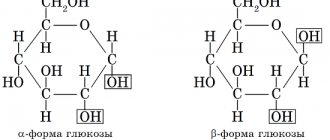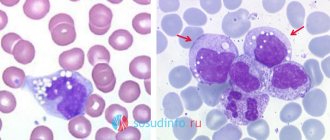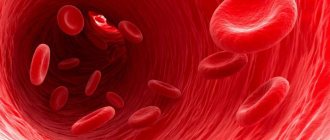When leukocytes in the blood are elevated, the causes in women can be physiological or pathological. If a woman’s blood test accidentally reveals an overestimated number of these cells, but she feels well, then there is no reason to worry. Leukocytes react to any changes in the body, especially in women, because they are more susceptible to various hormonal changes and other external and internal factors than men. So the number of white blood cells is constantly changing, these readings in the blood indicate the presence of a disease or the influence of physiological factors.
What are leukocytes responsible for?
Blood cells that have certain similar parameters are called leukocytes. They have no independent color, which is why they are also called white blood cells. They are formed in the red bone marrow.
Leukocytes are designed to protect the human body from the negative effects of various factors. This is their main function. The fight also against pathogens and foreign substances, products of cell decay. Leukocytes take an active part in the body's immune reactions.
Blood cells are divided into groups, each of which performs a specific function:
| Name | Description |
| Neutrophils (microphages) | Cells are distinguished by degree of maturity (young, rod-shaped, segmented). The main function of neutrophils is phagocytosis, eating and digesting pathogenic microorganisms. They are also responsible for transporting important biological substances and promoting the restoration of damaged tissues. |
| Eosinophils | Blood cells that protect the human body from parasitic, allergic and infectious diseases. They are involved in cancer and autoimmune processes. |
| Basophils | They are responsible for complex immunological reactions, support the process of blood clotting, vascular permeability and many other mechanisms in the human body. |
| Lymphocytes | They take part in immune reactions and support the production of antibodies. |
| Monocytes (macrophages) | Absorb and digest foreign bodies. |
If the number of white cells in the blood increases, the phenomenon is called leukocytosis. In some situations, it goes away on its own; it is enough to eliminate the provoking factors. Sometimes therapy specially selected by a doctor is required.
What to do if the white blood cell count is outside the normal range?
It is impossible to make a correct diagnosis based on the leukocyte count alone. If a deviation from the norm is detected, the doctor prescribes additional studies. These include:
- detailed leukocyte formula;
- determination of erythrocyte sedimentation rate;
- ultrasound examination, which will help visualize and quickly detect pathologies of internal organs;
- red bone marrow biopsy, which examines the cellular composition;
- immunogram and determination of the activity of various antibodies.
It is also worth paying attention to recent events in a woman’s life. She may have had a strong emotional experience, infection, or trauma that causes a temporary change in her white blood cell count.
Many patients neglect blood tests and self-medicate. This is a very wrong approach, since only a doctor can assess the nature of the disease and decipher the leukocyte formula. In order not to further harm the body, treatment should be carried out after receiving laboratory results. It is possible to return the normal level of leukocytes only by eliminating the underlying cause.
The mechanism of formation and destruction of blood cells
When a foreign body enters the human body, a large number of leukocytes are activated. They can penetrate the walls of capillaries. After their encounter with pathogenic agents, the fight begins. Blood cells absorb foreign bodies.
During the struggle, an inflammatory process occurs. Its intensity and extent of spread depends on the size of pathogenic microorganisms and their activity. A person’s body temperature rises, the skin turns red and swells at the site of inflammation. After absorbing foreign bodies, leukocytes are destroyed.
Dead cells leave the body in the form of pus. This process is called phagocytosis.
When a small splinter gets into the skin, leukocytes deal with it on their own. They completely destroy it and bring it out, and a small amount of pus appears. If affected by a large foreign body, the person will need surgery to remove it and the purulent accumulations along with it.
Reasons for the downgrade
If an adult has a white blood cell count below the normal level, this also signals abnormalities in the body. The reason for this may be:
- viral infections, including influenza, hepatitis, AIDS;
- immune diseases;
- malaria;
- tuberculosis;
- anemia;
- radiation sickness;
- long-term adherence to a strict diet, exhaustion;
- leukemia;
- disorders of the thyroid gland.
Important information: What does it mean that the width of platelet distribution by volume is higher than normal?
Norm of leukocytes in blood by age
The level of blood cells in the human body fluctuates, it all depends on numerous factors.
Standard indicators for children, women and men are different:
| Age | Parameters (Unit/l) |
| Newborns (1-3 days) | 7-32x109 |
| Less than 1 year | 6-17.5x109 |
| 1-2 years | 6-17x109 |
| 2-6 years | 5-15.5x109 |
| 6-16 years | 4.5-13.5x109 |
| 16-21 years old | 4.5-11x109 |
| Adult woman | 3.98-10.4x109 |
| Grown man | 4.2-9x109 |
| Elderly woman | 3.7-9x109 |
| Old man | 3.9-8.5x109 |
In people over 60 years of age, the level of leukocytes does not rise to critical levels, since the immunity of an elderly person is weak. To obtain accurate information about the state of the blood and the number of blood cells, the percentage ratio between the groups (leukocyte formula) is determined.
Normal for men
In representatives of the stronger sex, the normal level of this blood element varies within the same limits as in women. But the value also depends on age:
- From twelve to eighteen years from 3.5 to 8*109/l.
- From eighteen to twenty-five from 4 to 9 *109/l.
- From twenty-five to forty years from 4 to 7 *109/l.
- Over forty from 3 to 7 *109/l.
On the subject: What is isometric (also known as static) load and why is it needed?
In what cases does a low white blood cell count occur? More on this below.
How is the level of leukocytes in the blood determined? Preparing and conducting analysis
An increased level of leukocytes in the blood can be diagnosed by a general practitioner or pediatrician. If necessary, the child or adult will be prescribed additional examination to make an accurate diagnosis. In some situations, consultation with an allergist and infectious disease specialist is required.
The following methods are used to diagnose leukocytosis:
- general and detailed blood test;
- biopsy of bone marrow, lymph nodes, spleen, liver;
- peripheral blood smear.
Biological material is taken from the ring finger of the left hand or from a vein. For an adult, the second option is preferable, since children are afraid of syringes. And blood is taken from a finger by using a scarifier. The highest quality material with which you can obtain the most accurate data is venous blood.
Rules for preparing for analysis:
- donate blood in the morning on an empty stomach;
- the day before the analysis, exclude alcohol, medications, physical activity and overheating of the body;
- reschedule physiotherapeutic procedures, x-rays or massage to another time;
- Repeated blood donation is recommended at the same time;
- Before entering the manipulation room, you should rest for 10-15 minutes and sit.
If you cannot donate blood in the morning on an empty stomach, the doctor recommends doing it after a meal, no less than 3 hours later. The examination results will be ready in 1-2 days.
What you should know about the norm of the substance
The norm for leukocytes in the urine of women and men will vary depending on the following phenomena and factors:
- An excess of even one leukocyte serves as a signal for additional research. According to immunologists, such scouts serve as an indicator that there are minor problems. But their immune system can decide on its own. They signal when an infection occurs and promote the production of antigen.
- It is imperative to look at the state of permeability of blood vessels and their walls. The fact is that white cells are able to penetrate from the blood, but they do not affect the state of health.
An excess of even one leukocyte in the urine of women serves as a signal for additional research.
How many leukocytes should there be in the urine? For each gender, these indicators are changed. So, in the female half of humanity, up to 6 pieces are normal when collecting material. But for men, such a figure will be considered a deviation. The maximum permissible figure in analyzes of strong representatives reaches three.
If we talk about children, then they look at gender characteristics the same way:
- girls – maximum 10;
- boys - 7.
Why such differences? The fact is that the normal number of leukocytes in the urine directly depends on the anatomy. The structure of the female genitourinary system is different from that of the male. Thus, the female genitourinary system is hidden entirely in the abdominal cavity. Therefore, the organs are all nearby and any bacteria can migrate through them. Because of this, there is an increase in all indicators, including leukocytes.
Often you have to retake the test material due to improper urine collection
Often you have to retake the research material due to improper urine collection. It will not be possible to hide negligence, since the indicators of white cells immediately increase and can reach 10. It is worse if the entire collection procedure was carried out correctly and a repeated examination shows the same result. This indicates obvious pathology. Most often, such indicators indicate disorders that have occurred in the kidneys. A urologist or gynecologist, having received these results, sends the patient for further examination:
- ultrasound examination of the abdominal cavity;
- study of the kidneys using different methods;
- bac sowing For this, urine is again used, but research is now carried out using different methods;
- epithelial scraping.
Decoding the research results
Laboratory tests are necessary to make an accurate diagnosis. It is important not to delay visiting a therapist, since leukocytosis can be caused by a serious pathology. The doctor will interpret the diagnostic results and, if necessary, prescribe treatment.
| Name | Description |
| Normal white blood cell count. | Considering a person’s age, the level of leukocytes in his blood is constantly changing under the influence of certain factors. Women have higher levels of blood cells compared to men. |
| Increased performance. | An increase in the level of leukocytes occurs due to pathological or physiological factors. Parameters rise after eating, physical activity, emotional stress, and during pregnancy. In the period after surgery, also in case of burns or injuries. |
| Decreased leukocytes. | Low blood cell counts occur with long-term use of antidepressants, anticonvulsants, antihistamines, heart medications, or chemotherapy drugs. In some situations, pathological changes occur due to a failure of material metabolism, autoimmune diseases, radiation sickness, blood cancer, or the presence of HIV infection. |
Significantly elevated rates indicate the development of numerous pathologies. This is radiation sickness, a malignant tumor, an exacerbation of inflammation.
How to determine leukocytes in women over 50 years of age in urine?
Leukocytes in women can also be determined by submitting urine for a general analysis . The results of the analysis depend on how the urine is collected for analysis.
How to properly collect urine from a woman?
- Only morning urine is collected.
- The external genitalia should be washed thoroughly.
- Passing a small amount of urine into the toilet.
- The next urine is collected in a clean jar.
- The rest of the urine goes back into the toilet.
The norm of leukocytes in women in urine is 0-5 units from 2 drops of urine examined under a microscope . If there are 6-7 units of leukocytes, this is an increased value , and the doctor may prescribe another test to make sure that the test was done correctly.
This is what a general urine test looks like
Reasons for increased leukocyte levels in women, men, children, and pregnancy
An increased content of leukocytes in the blood occurs more often when pathogenic microorganisms enter the human body. Parameters also change under the influence of numerous factors, including harmful products and loads.
The figure lists the causes of increased levels of leukocytes in the blood.
There are also physiological and pathological provoking circumstances:
| Causes | Description |
| Physiological. |
|
| Pathological. |
|
After the spleen is removed, the number of blood cells changes dramatically. Sometimes a high level of white blood cells occurs in a healthy person. The reason for this may be physical activity or a full stomach during research.
What is the reason for the increase in leukocytes?
In 1 ml. The blood of every healthy person contains 4000-10,000 leukocytes. The condition in which their number exceeds this value is called leukocytosis.
Depending on the cause that provoked its occurrence, leukocytosis can be physiological and pathological.
A physiological increase in the number of white blood cells that does not require treatment may occur:
- When using steroids,
- After administration of any vaccine,
- Before the start of menstruation,
- During pregnancy,
- During childbirth,
- After intense sports activities (running, boxing, fitness, etc.) and heavy physical labor,
- After eating (so that this is not reflected in the analysis, blood is donated only on an empty stomach),
- In hot weather,
- As a result of taking a contrast bath.
Normally, the blood of an adult may contain 4-9x109/l white blood cells. If there are more leukocytes than normal, this means that some kind of pathology has arisen in the body.
Pathological leukocytosis can result from:
- Blood diseases (anemia, leukemia),
- Infectious diseases of bacterial etiology (represented by pyelonephritis, meningitis, tonsillitis, pneumonia),
- Myocardial infarction,
- Inflammatory processes (with abscesses, peritonitis, appendicitis, infected wounds),
- Tumor processes,
- Extensive burns
- Carbon monoxide poisoning,
- Taking a range of medications.
In what cases can a high level of leukocytes be considered normal?
In some situations, leukocytosis is normal. Even elevated levels may be normal.
Such pathological changes are called physiological leukocytosis and occur against the background of the following factors:
- bad habits (cigarettes);
- stressful or severe emotional shock;
- poor diet (there are foods that negatively affect the level of leukocytes);
- pregnancy (during carrying a baby, various changes occur in the expectant mother’s body, including an increase in the level of blood cells);
- hot air (sunbathing, work environment, baths, saunas, production workshops).
An increased level of leukocytes in the blood is observed after sports or physical activity. During diagnosis, it is recommended to refrain from smoking and eliminate the influence of provoking factors in order to obtain the most accurate results. The blood test is performed on an empty stomach in the morning.
What is the optimal leukocyte norm, correspondence table
Let us consider the available and known types of leukocytes: granulocytes and agranulocytes. Granulocytes include neutrophils, eosinophils, and basophils. Agranulocytes include monocytes, macrophages, lymphocytes. Leukocytosis is accompanied by a large number of leukocytes, and leukopenia is accompanied by a decrease in them.
For a woman, the white blood cell count is analyzed in three ways: blood, urine and smear tests.
After fifty, women are subject to hormonal changes in the body. The period when the body stops producing certain hormones, the supply of white blood cells increases significantly, slowly and smoothly replacing hormonal work. However, after the end of the menopause, there is a decline in the formation of certain hormones and cells, including leukocytes. The general composition of white blood cells in elderly women is from 3.7 units. up to 9.0 units by 10^9 cells per liter of blood.
- From forty-five to fifty-five years - the period of menopause, reproductive functions decline significantly, and during which sex hormones cease to be produced - from 3.3 units. up to 8.8 units at 10^9 cells per liter.
- 55-65 years, the period of decline in all vital functions that regulate hormones is 3.1-7.58 per 10 9 units. per liter Pathology or dysfunction is considered to be a deviation from the norm of 10–15 units, shown in the table.
Symptoms of leukocytosis
The clinical picture of disorders in the human body allows the doctor to make an accurate diagnosis. It is important to choose the most effective treatment for leukocytosis in order to prevent possible complications.
The main symptoms of an increased level of white blood cells:
- body temperature rises;
- vision is impaired;
- breathing becomes difficult;
- frequent bruising or bleeding occurs;
- pain or tingling sensations occur in the abdomen, lower and upper extremities;
- weakness in the body, fatigue appears;
- the spleen and liver enlarge;
- my head is spinning.
Sweating, fainting, poor appetite and, as a result, reduced body weight also indicate a low blood cell count.
What function do leukocytes perform?
The norm of leukocytes in the urine of women, men and children differs from each other. But the function of these substances or bodies is the same. They serve as an indicator of health or the body’s protective reaction. One might even say that in this way the immune system gives an account of its activities. You can identify or find such a “report” in collected morning urine. This is why they take a general analysis. Naturally, such an examination, if necessary, is carried out at any time of the day, but to be sure, the information received will be duplicated using the morning collection of material.
The norm of leukocytes in the urine of women, men and children differs from each other
The generation of white cells, which is what leukocytes are called, occurs due to the bone marrow and lymph nodes. If nothing threatens a person’s health, and there are no viruses or bacteria, then the norm and number of leukocytes in the urine will be either insignificant or completely absent. To determine the norm, use a table. After carrying out and removing all the substances, look at the result. The urine of a healthy person, regardless of gender and age, should be:
| indicators | norm |
| Salts and bacteria | None |
| Cylinders and hemoglobin | None |
| Epithelial cells | Present in the field of view in an amount of no more than 5 |
| red blood cells |
|
| leukocytes |
But the best indicators are in the field of view, i.e. from 0 to 3 |
| Bilirubin and ketone bodies | Not allowed |
| Glucose | Can reach 0.7-0.8 mmol |
| Protein | The best option if absent, but if in quantity 0.03, then it is also allowed as not a deviation |
| General characteristics | A healthy person's urine may be light yellow or straw yellow. Transparent and without sediment. You can always notice violations of general indicators yourself |
How to reduce the level of leukocytes in the blood
There is no specific treatment for leukocytosis; it is enough to eliminate the negative factor and the level of blood cells will be restored. Therapy is required if, after diagnosis and following the rules, the indicators are still high. They indicate the development of pathological processes in the human body.
Drug treatment
Medications help increase the white blood cell count in the blood. Medicines are prescribed by a doctor after diagnosing and making an accurate diagnosis. It is important to follow the recommendations of a specialist, since symptomatic treatment can cause side effects.
| Group of drugs | Name | Application |
| Antibacterial agents. | Azithromycin, Clarithromycin. | Prevents the development of sepsis and eliminates the infection that caused the increase in leukocyte levels. The medicine is taken 0.5 g per day for 3 days. |
| Corticosteroid drugs. | "Prednisolone", "Dexamethasone". | Reduce the inflammatory process. The initial dosage is 20 to 30 mg in the morning. |
| Antacids. | "Almagel", "Maalox", "Gastal". | Reduce the volume of uric acid. Recommended dosage: 5-10 ml 3 times. per day for 12 days. |
| Medicines to lower uric acid levels. | "Probenecid", "Sulfinpyrazone", "Allopurinol". | Prevents tissue destruction in the human body against the background of leukocytosis. Reduces and removes uric acid from the human body. The minimum dose of probenecid is 250 mg, which is gradually increased from day 2 to 2000 mg over 4 weeks. |
| Antihistamines. | "Tavegil", "Suprastin". | Relieves allergic symptoms. Take 2 ml morning and evening. |
In some situations, leukapheresis (a procedure to remove excess white blood cells) is used. Homeopathic medicines have a positive effect on the body, helping to restore numerous internal processes.
Traditional methods of reducing leukocytes
To reduce the level of blood cells, you can use recipes from witch doctors and healers, but only after consulting a therapist or pediatrician. Folk remedies can provoke an allergic reaction, so it is important to avoid self-medication.
| Name | Recipe | Application |
| Oat based decoction | Pour 2 tsp. grains with water (1.5 tbsp.) and put on low heat. Bring to a boil, heat through and set aside for the whole day. | For leukocytosis, it is recommended to drink the resulting solution 1/3 tbsp. 2 r. per day for 1.5 months. The medicine must be taken on an empty stomach. |
| Infusion of sweet clover | Pour dry grass (2 tsp) with hot water (1.5 tbsp) and leave for 4 hours. | Drink 3 r. per day for a month. |
| Rose hips with strawberries and nettles | Mix the components in equal proportions, add water (500 ml) and place in a water bath. Heat for 20 minutes. and leave for an hour. | For leukocytosis, take 50 ml 3 times. per day for at least a month. |
| Blackthorn berries | Pour the fruits of the plant (1 kg) with water (400 ml) and grind. Leave for 24 hours, then put on fire. Heat for 10 minutes, cool to room temperature and strain well. | Drink the medicine 3 times. 50 ml per day on an empty stomach. You can add sugar or honey for taste. The recommended course of therapy is 2-3 weeks. |
| Melissa leaves | Pour 200 g of fresh leaves with hot water (500 ml). Leave for at least an hour, strain and take every day. | It is recommended to drink 1 tbsp. 3 r. per day. |
An increased level of leukocytes in the blood can be eliminated with folk remedies, but as an adjuvant therapy. The main treatment is prescribed by a therapist. The doctor also recommends drinking more fluids and fresh juices from carrots and beets.
Deciphering the leukocyte blood formula
Leukocytes are several types of cells that make up the blood, which, unlike red blood cells that transport oxygen throughout the body, perform an immune function - they protect against infections. In the analysis results, they may be designated by the abbreviation WBC (from English white blood cells, which translates as “white blood cells”). The percentage ratio between them, calculated during the research process, is called a leukogram, or leukocyte formula.
During the analysis, all types of a given type of blood cell are counted:
- Granulocytes, also called granular cells, are the most numerous group, their number accounts for up to 80% of all white blood cells. These include: neutrophils (band and segmented granulocytes);
- eosinophils;
- basophils.
- lymphocytes;
- Deciphering a smear for flora
- Neutrophils are low in the blood of adults and children. Causes, treatment and degrees of neutropenia
- Causes of elevated monocytes in a blood test - normal level in children and adults
The normal number of leukocytes in the blood of women
Indicators (norms) differ for people of different ages and genders, and also depend on the physical condition of the person. For example, their level increases after physical activity or in the evening, when daytime fatigue takes its toll. WBC levels in women increase during pregnancy, after childbirth, and during menstruation. How many leukocytes should an adult woman have in her blood? Look at the acceptable numbers in the table below, which shows the designation of white blood cells in a blood test and their normal limits.
| Index | Normal limits |
| Leukocytes | 4-9*109/l |
| Band granulocytes | 1-6 % |
| Segmented granulocytes | 47-72% |
| Eosinophils | 0-5% |
| Basophils | 0-1% |
| Lymphocytes | 18-40% |
| Monocytes | 2-9% |
Increased leukocytes in the blood
An increased content of an analysis parameter is said when the amount exceeds 9*109/l. This change in blood composition is called leukocytosis. A very large excess of the norm (50-80*109/l) may even indicate leukemia - blood cancer. What exactly such a high concentration of white blood cells indicates can and should only be determined by a specialist, because this condition can be caused by a variety of factors.
Causes
In some conditions of a woman, an increase in the WBC indicator is a variant of the norm: for example, the numbers can be increased after childbirth or if a woman feels very hungry, or even immediately after eating. Leukocytosis during pregnancy is not considered a disease, which, in addition to the natural increase in this parameter during this period, can even be caused by ordinary thrush (candidiasis) in a pregnant woman.
If factors that could distort the test results are excluded, the doctor determines which root cause activated the growth, for example:
- bacterial or viral infections;
- traumatic injuries to the body, suppuration, burns;
- allergic reaction;
- food poisoning that caused vomiting, diarrhea;
- renal failure;
- acute appendicitis, etc.
How to downgrade
It is possible to bring the number of leukocytes in the blood of women to normal by influencing the reasons that violated it. So, if such an indicator appears due to physiological reasons - overwork, stress - you need to normalize your work and rest schedule, eat right, prevent the body from overheating and not get too cold. If a disease has led to an increase in the WBC number in the formula, then the tests are normalized due to the treatment of the disease. Appropriate treatment measures should be selected only by a general practitioner or hematologist based on his diagnosis.
- Leukopenia - what it is and its causes. Signs and symptoms of leukopenia in children and adults
- ESR is normal for age. ESR is higher than normal - what does it mean?
- Urine analysis for leukocytes: explanation
Leukocytes in the blood are low
A decrease in the level of white blood cells indicates leukopenia. This is a dangerous condition for health because it indicates a significant decrease in the body's defenses. If the indicator of this blood component in a woman is less than 3.7 * 109/l, this is already a signal about the presence of the disease. In cases where the low level of leukocytes approaches 1.7 * 109/l, they speak of the development of a serious blood disease. If your WBC is low, you should immediately see a qualified doctor.
Reasons for low level
Correct diagnosis of leukopenia is very important, because such changes can be caused by serious disturbances in the process of production of white blood cells. This happens when:
- disturbances in the normal process of component formation by the bone marrow due to injury or cancer of this organ;
- insufficient amounts of microelements and organic substances - B vitamins, copper, iron;
- if a person is sick with radiation sickness, AIDS, autoimmune disease;
- with congenital predisposition.
The second group of reasons that causes a decrease in numbers in analyzes is a decrease in the number due to death after performing protective functions. This happens when:
- development of an infectious disease;
- disruption of the spleen and liver;
- increased cell destruction as a result of long-term use of medications or the effects of strong medications, for example, chemotherapy;
- hormonal disorders.
Promotion
Identified leukopenia necessarily requires qualified treatment to restore the body’s ability to defend itself. Along with the impact on the disease that caused such a deviation from the norm, you need to use drugs that stimulate the production of white blood cells, and pay attention to your diet and take the necessary vitamin complexes.
Complications of leukocytosis
Without timely assistance from a therapist or pediatrician, an increased level of leukocytes can provoke a worsening of the disease against which the pathological disorders appeared. The likelihood of it becoming chronic increases. Frequent exacerbations will occur, and the symptoms of the pathology will intensify.
If treatment is delayed, the immune system will deplete. The human body will not be able to resist other diseases. Leukocytosis can also provoke leukemia or the appearance of malignant neoplasms. Neutropenia and anemia result from increased blood cell counts. They negatively affect the mental and physical development of a person.
You can prevent an increase in blood cell counts by maintaining your immunity, leading a healthy lifestyle, and eating right.
A high level of leukocytes in the blood is not a fatal disease, but without consulting a therapist, it can provoke serious complications and the development of dangerous pathologies. Timely consultation with a doctor will prevent negative consequences.
How to treat leukopenia
Treatment of leukopenia should only be carried out by a doctor. The doctor will determine the causes of the pathology and prescribe effective therapeutic measures
It is important to know that leukopenia does not have any special symptoms
The number of leukocytes in the blood does not affect the patient’s well-being. But if the reduced rate persists for a long time, then the woman will develop an infectious disease that will have symptoms.
Video:
The patient should not self-medicate, as in this case the infectious disease will quickly take hold of the body. As a result, the patient may experience septic shock, a condition that can be fatal.
If the patient has been diagnosed with leukopenia, then the woman should not allow herself to become infected with infectious diseases.
To do this, you can use several tips:
- You should wear a protective mask in public places;
- avoid contact with people who have viral infections;
- do not eat unprocessed foods - vegetables, fruits, farm products;
- the patient should eat right, lead a healthy lifestyle, and sleep enough time.
If a woman suffering from leukopenia has a fever, she needs to urgently consult a doctor or call an ambulance.
Before starting treatment, the doctor must conduct a full examination of the patient and find out the reasons that caused the decrease in the number of leukocytes.
After the tests, medications will be prescribed that will stimulate the production of white blood cells.
If the patient has autoimmune disorders, she will be prescribed Leukogen. There are a number of other medications that are prescribed by a doctor depending on the cause of the problem.
Treatment can be supplemented by taking folk remedies. Rosehip decoction will help raise the level of leukocytes.
The fruits should be washed with clean water and placed in a thermos. After boiling water is poured into the container, close the lid tightly and leave overnight. It is recommended to drink the liquid instead of water.
You can cook oatmeal jelly. To do this, pour the oats with water and place them in a water bath, where the container sits for about 30 minutes.
After this, the liquid is placed in a dark place for several days. Kissel should be strained and drunk with a spoon before eating.
All products have contraindications
It is important to consult your doctor before starting to take medications. Self-medication will not only not cure the disease, but will also lead to dangerous consequences.
Bone marrow lesions
More serious conditions when white blood cells are elevated are leukostasis, leukemoid and leukoerythroblastic reactions. All of them can lead to death, since they are a type of oncology.
Leukostasis occurs due to the retention of a large number of leukocytes in the capillaries and small vessels of the brain, lungs and kidneys, which form leukocyte blood clots. Leukostasis can cause death due to poor circulation and severe deficiency of substances that are necessary for the proper functioning of the brain. If leukocytes in the blood are elevated during leukostasis, this is most common in myeloid leukemia, and much less common in chronic lymphocytic leukemia. A large number of myeloid blasts can increase pure leukocins.
Leukemoid reactions are characterized by the presence of immature leukocytes (blasts, promyelocytes, myelocytes and metamyelocytes) in the peripheral circulation. Leukemoid reactions can be secondary to malignant or benign tumors. The values of white cells in this disease are very high, and in the blood test, leukocytes range from 50 to 100 x 109 cells per liter, which is significantly higher than the normal number of leukocytes.
The leukoerythroblastic reaction is similar to the leukemoid reaction, but involves an increase in red blood cells. In this case, a disorder of bone marrow activity occurs, which often occurs with myelofibrosis (primary or secondary). Leukoerythroblastic reactions give rise to assumptions about the presence of extramedullary hematopoiesis, which often occurs with cancer metastases (a condition when a tumor releases cancer cells into healthy tissues). In infants, these reactions are accompanied by severe hemolytic anemia, called erythroblastosis fetalis.
Another disease in which there are elevated white blood cells in the blood and the bone marrow is affected is osteopetrosis. This rare disease appears in childhood. In this case, disturbances appear in osteoclasts, which become incapable of resorption of bone tissue. Therefore, bones lose their ability to change shape and grow, and the bone marrow cavities, in which blood should be produced, are replaced by other tissues. In this case, hematopoietic elements penetrate into the peripheral circulation.
How does age affect the white cell count?
The norm of leukocytes in the urine of women after 50 years and, say, a pregnant woman will vary. Plus, in adolescence they change significantly. That is why, when issuing a referral to the laboratory, the doctor indicates the age and gender of the patient. This is necessary to obtain reliable results.
The norm of leukocytes in the urine of women after 50 years and, say, a pregnant woman will vary
It is worth considering all possible options that may arise during the examination.
Women
According to the table, it is clear that the maximum level of white cells can reach 6. Better, of course, is zero. There is one distinctive feature that only women take into account - menstruation or bleeding. Once blood gets into the material, it dramatically changes the indicators and distorts the result. The level immediately increases. In any case, it will be necessary to re-examine the material.
Pregnancy
Not only hormonal changes occur in the body of a pregnant woman. All organs begin to function differently. Accordingly, the indicators of all substances will be changed. This fact is in any case taken into account when examining urine. So, in a woman’s normal condition, a number reaching 10 is a deviation. And during pregnancy - the norm. Exceeding this mark is evidence of ongoing inflammatory processes. Additional tests are carried out immediately. Most often this is an ultrasound and a smear. Such an increase can cause candidiasis, cystitis, colpitis and kidney or urinary stones. But the woman independently notices the appearance of discomfort.
50+ or older women
The norm of leukocytes in the urine of women after 60 years ranges from 4, but does not exceed 6 units. Any slight deviation indicates kidney stones and salt deposits. Unfortunately, the indicators at this age are always overestimated, since the presence of these diseases in older people occurs constantly.
Male
The stronger sex has a completely different structure; there are no such hormonal surges as women have at different periods of life. Hence the reason for such a norm as a complete absence of leukocytes or a maximum of 2 units. As the age of 50+ approaches, this figure increases to 4, and by the age of 60 it becomes 6 units.
795
We recommend that you read
Urine and blood tests Read more » What do casts in urine mean? 2 801
Urine and blood tests Read more » Oxalate salts in urine: what does it mean? 842 5
Categories
- Inflammation of the kidneys Nephroptosis
- Pyelonephritis
- Urine and blood tests
Recent Entries
- Is it possible to donate urine during menstruation for tests and how to do it correctly
- Diet for kidney inflammation - what you can and cannot eat
- Diet for renal colic - what you can and cannot eat
- Computed tomography of the kidneys using a contrast agent. Features and nuances
- Diet for urolithiasis in women and men
Types of leukocytosis
The results of a detailed blood test include information on each type of leukocyte, which makes it easier for doctors to make a diagnosis. Taking into account their features, you can immediately search in a specific direction. Based on this, leukocytosis is divided into the following types.
Neutrophilic - characterized by a sharp increase in the number of cells of the same name, which, in turn, are divided into rod (young) and segmented (mature). The shift occurs due to the development of an acute long-term inflammatory process, bacterial infection, significant blood loss and intoxication of the body.
With these pathologies, both the so-called rods in the blood and mature neutrophils increase, since the former are intensively produced, and then their intensive maturation occurs. Increased leukocytosis of this type is observed with the appearance of malignant pathologies of the bone marrow, but such cases have been recorded quite rarely in medical practice.
Eosinophilic - also indicates the development of inflammation, but most often the growth of this variety is due to allergies, not excluding a reaction to certain medications. Basophilic – noted in diseases of the spleen, thyroid gland and digestive organs.
Lymphocytic – characteristic of severe infections, for example, tuberculosis and hepatitis. This variety is also greatly increased in measles, rubella and chickenpox. Monocytic - occurs during the recovery stage after severe infectious diseases. Often observed in patients undergoing long-term therapy for tuberculosis. Quite rare, but still happens in cancer patients.
Signs of leukocytosis
A condition in which there is an increased number of leukocytes does not have specific, that is, symptoms inherent only to it, since it is not an independent disease. That is why its manifestations are based on the symptoms of the pathology that caused the increase in white cells. Such signs may include:
- feeling of constant fatigue;
- causeless general weakness;
- excessive sweating (especially at night);
- slight increase in body temperature;
- presyncope (fear of losing consciousness);
- dizziness and fainting (most often short-term);
- the appearance of bruises and bruises in the absence of injuries;
- pain in the abdominal cavity and limbs;
- loss of appetite and body weight, problems with respiratory function;
- noticeable visual disturbances.
Reference! Exceeding the white blood cell count is a dangerous condition that should never be left without due attention. This means that you need to visit a doctor as soon as possible and find out from him what to do in such a situation.
In all likelihood, after the consultation, the patient will be given a full examination, the results of which will reveal the reasons for the increase in the coefficient.
Increased rate in children
Leukocytosis in infants and slightly older children may not manifest itself in any way. It is diagnosed only by the results of a blood test. If, according to the examination materials, an increase in values was recorded in a newborn who is only a few days old, then he is diagnosed with congenital leukemia.
This condition is usually observed in cases of serious developmental disorders in infants: Down's disease, body defects, heart defects, and is a fairly rare pathology. The number of white cells in the blood of a baby over one year old can increase, just like in an adult, for physiological reasons:
- improper or unbalanced diet;
- excessive physical activity for the child’s body;
- psycho-emotional overstrain and stress.
Parents are obliged to be attentive to the health of their child and not subject him to unnecessary everyday and social difficulties. In addition, they must monitor the diet and quality of food, and also save the baby from unpleasant worries. Parental attention is especially important for teenagers who experience many negative moments due to hormonal changes.
The main pathological causes of high levels of leukocytes in children include leukemia and infectious diseases. Moreover, if these cells are slightly enlarged, then, in all likelihood, the developing disease is mild or moderate, whereas with very large growth, as a rule, the pathology is very serious and life-threatening. For example, with sepsis, leukocytes can reach a value of 100*109/l and higher.
Other causes of leukocytosis
An increase in monocytes can occur in a number of diseases, especially in the recovery phase after infections. But it can also be the result of malignant tumors, especially myeloproliferative ones. Monocytosis can be the result of viral, fungal infections, and helminthic infestations.
An increased number of monocytes can provoke hemophagocytic syndrome, in which there is increased phagocytosis of red blood cells, leukocytes and platelets. This syndrome often results from viral and bacterial infections and also occurs in malignant T-cell lymphoma.
Elevated eosinophil counts are associated with various forms of immunological damage. With the accumulation of large quantities of eosinophils, the formation of crystal-like structures (Charot-Leyden crystalloids) is possible. Eosinophilia can be provoked by:
- Allergic diseases.
- Asthma.
- Eczema, atopic dermatoses.
- Parasitic infections – trichinosis, worms, schistosomiasis.
- Various infectious diseases: scarlet fever, tuberculosis, leprosy.
- Loeffler's syndrome.
- Pulmonary infiltration with eosinophilia.
- Medicines – sulfonamides and others.
- Neoplasms – tumors, Hodgkins disease.
An increase in basophils is observed during allergic reactions, and may also indicate chronic myelocytic leukemia. An increase in the number of basophils is associated with polycythemia vera and extramedullary hematopoiesis. Basophilia also occurs with hypothyroidism, when the thyroid gland does not produce the required amount of hormones.
Why do lymphocytes increase?
The level of lymphocytes most often increases with viral infections and much less often with bacterial ones. One of these diseases is infectious mononucleosis, which is accompanied by an increase in B lymphocytes. In infectious mononucleosis, 10% of lymphocytes acquire an atypical shape, and an increase in small lymphocytes is observed. During the second week of the disease, an increase in activated cytotoxic T lymphocytes occurs. These killer cells destroy infected B lymphocytes.
Infectious mononucleosis most often affects adolescents and young adults. Symptoms of this disease are:
- Temperature.
- A sore throat.
- Lymphadenopathy (enlarged lymph nodes).
- An enlarged spleen is common.
This disease most often manifests itself in childhood and is benign. Its cause may be Kossak virus or B6, echovirus and adenovirus 12 (in the latter case, enlarged spleen or lymphadenopathy do not occur).
HTLV-1 virus can cause transient lymphocytosis with high fever, rash, and mild lymphadenopathy. In most cases, this disease goes away, but sometimes a complication can occur - T-lymphocyte leukemia.
Proper preparation for a smear test
Like most diagnostic tests in medicine, a flora smear requires preparation. When going to the gynecologist, a woman should remember that the test result will be reliable only if the following recommendations are followed:
- maintain sexual rest for at least 2 days before donating the biomaterial;
- stop using lubricants, vaginal suppositories, creams on the eve of the study;
- do not wash your face using gels or other intimate hygiene products;
- refrain from taking a test after a course of antibiotics (at least 10 days);
- do not urinate less than 2 hours before visiting a gynecologist;
- Do not get tested during menstruation.
Intimacy, any topical agents, antibiotics distort data about the real state of the microbial biocenosis of the genitourinary system in a woman.
What are leukocytes
Human blood is a connective, mobile tissue, divided into a basic liquid medium called plasma, as well as dense elements, which include:
- platelets;
- red blood cells;
- leukocytes.
What are leukocytes in the blood responsible for? In general, leukocytes are white blood cells that make up the middle layer of a gray hue in the settled part. If you examine blood in a laboratory setting under multiple magnification, the leukocytes look like small spheres that have an irregular shape and a rough surface. The white tint of leukocytes is due to the lack of color, which cannot be said about erythrocytes.
Leukocytes are synthesized, like other blood cells, by the bone marrow. The total amount of all formed elements in human blood is no more than 50%. The number of leukocytes should be an order of magnitude less than erythrocytes and platelets.
What are leukocytes in the blood designated as? Their letter designation in a blood test is WBC - White Blood Cells.
Types of leukocytes
The main indicator that determines the state of human health is not only the total number of leukocytes, but also the percentage of their types, according to which experts put forward various hypotheses about the reasons for the deviation from the norm. The main types of white blood cells include:
- Neutrophils. These elements are included in the number of granular leukocytes. If their level falls, this will lead to the loss of the human body’s ability to protect itself from various direct and bacterial infections. Neutrophils that have died appear as pus at the site of inflammation.
- Lymphocytes. Lymphocytes are the main defenders of the human body in the presence of viral infections. They are the ones who destroy and recognize foreign agents.
- Monocytes. The main role of monocytes is that they cleanse the inflammation site from dead various foreign particles.
- Basophils. Basophils are considered auxiliary cells that mobilize other granular leukocytes to the main site of the inflammatory process.
- Eosinophils. These granulocytes perform an antiallergic function in the human body.
Causes of leukopenia
If the function of the bone marrow is impaired, then it can no longer produce leukocytes in the required volume, and their indicator drops by two units or more, while remaining at a minimum level for a long time. From analysis to analysis, this indicator begins to decrease. In adults this happens for the following reasons:
- the presence of malignant diseases of lymphoid tissue;
- chronic diseases that are infectious in nature;
- low-quality tumors;
- metastases in the bone marrow;
- severe blood loss;
- hepatitis;
- intoxication.
A decrease in white blood cell levels may also occur due to the use of non-steroidal drugs and antibiotics, as well as in the presence of sepsis. Low leukocytes in the blood of a child are observed due to a pathological process, which is predominantly congenital in nature. Specialists place special emphasis on:
- bone marrow hypoplasia or aplasia;
- vitamin B12 deficiency.











